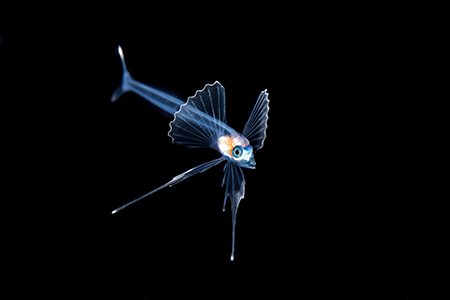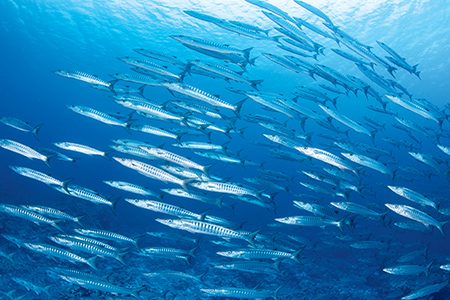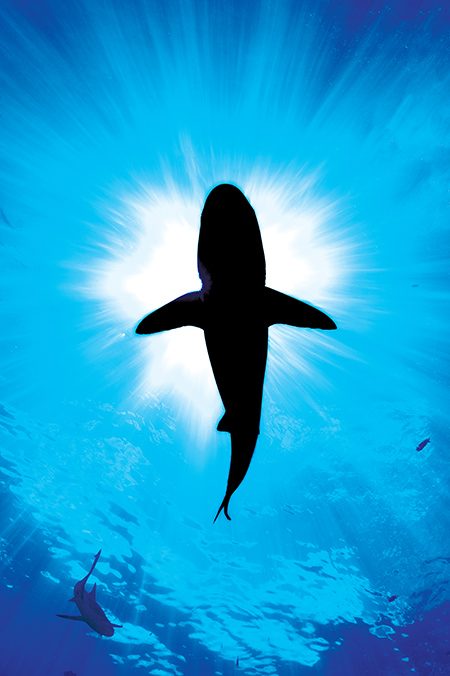Island of Pure Magic
The morning sun is low, and the ambient temperature is cool as our boat skims smoothly across the glassy waters of Yap’s eastern lagoon.
Shallow coral heads are on both sides of the M’il Channel opening as we slow down to locate our mooring ball. The incoming tide brings clean, blue water into the lagoon, creating opportunities for encounters with one of Yap’s main attractions just a few feet below the surface.
More than 30 years ago, the dive travel landscape was much different than it is today. The information supply chain was slow, and most divers learned about new destinations from dive magazines. It was then that now-legendary diver Bill Acker made a discovery that put the tiny island of Yap on the dive map.


Acker discovered that reef manta rays (Mobula alfredi) entered lagoons through the channels at certain times of the year to visit their favorite cleaning stations. The mantas alternated from one lagoon to another depending on the season but always visited the same locations. The sightings became so frequent that people began naming the individual mantas. In addition to the resident host of rays, a steady mix of newcomers frequented the different cleaning stations around the tiny island.
Today we know many places where divers can see mantas, but Yap was the first place for divers to have reliable encounters — and it still is.
Formed by an uplift in the Philippine Sea Plate, Yap pushes up from the Western Pacific Ocean nine degrees north of the equator. Despite its many similarities to an atoll, Yap is regarded as a high island because its volcanic rock is exposed above the ocean’s surface.
Along with its sister islands, Yap belongs to the Federated States of Micronesia, a chain of more than 600 islands sprawling throughout this corner of Oceania, which also includes Palau, Chuuk, and Guam. Flights arrive there daily from Palau and weekly from Guam.
On a map, the small island isn’t more than a speck in the ocean, but don’t let that fool you. Just under the surface surrounding Yap, a mass of marine life takes full advantage of the island’s healthy ecosystem.
In contrast to the jagged peaks of other Pacific islands, Yap’s landscape has low-lying rolling hills of long emerald-green grass, tropical vegetation, and lush thickets of healthy mangroves. The dense mangrove forest and the common barrier reef surround the island and form protective lagoons. Multiple channels within the reef allow ocean water to flow in while flushing out the nutrient-rich brackish waters of the lagoons during the daily tidal exchange. The complex network of mangroves, seagrass, and coral heads provides shelter and acts as a nursery for developing marine life by offering protection from larger predators and other natural elements.

The Yap Islands are composed of Yap Proper, Gagil-Tamil, Maap, and Rumung. In 1901 the arduous task of building a canal through dense mangroves was completed, deliberately separating Yap Proper from Gagil-Tamil and connecting the inner lagoons. The shallow canal is a busy waterway that allows small boats to safely navigate through the island and its dense mangrove forest instead of around it. We made good use of these canals each day of our stay as we hit the most active dive sites for the season.
When diving in Yap, you notice the wide variety and abundance of fish on nearly every dive. If I had to describe the fish activity around Yap in a simple phrase, it would be “one huge cleaning station.” Bluestreak cleaner wrasses and other varieties of cleaners are just about everywhere, flitting above the coral heads large and small on any of the more than 30 dive sites surrounding the island.


The cleaners’ rapid, undulating movements are a signal to other fish, and they tell divers acquainted with this common behavior that it is a great place to observe marine life. Fish of all sizes queue near the wrasses and wait their turn as the cleaners busily move about, servicing their clientele. The wrasses, usually working in pairs, quickly get to work when a client approaches. Different stations service different types of fish. Divers can see everything from butterflyfish to rays if the timing is right.
You can also observe manta cleaning stations within the channels at Stammtisch, Goofnuw Mini Wall,and Valley of the Rays. These natural wonders feature reef mantas, often in large numbers, trailing each other or swooping in from different directions with a single purpose. At Stammtisch, divers position themselves below the cleaning station to avoid damaging the corals.
We peered over the tops of a shallow, sprawling coral bed, with the surface only a few feet above us, but didn’t see any activity. After a few minutes, however, I noticed a few bicolored cleaner wrasses doing their dance. I looked over to signal my buddy and was shocked to see a massive ray gliding over his head without him even knowing. This empty patch of coral soon resembled a busy airport with rays lining up for their final approach.

The dive flipped from mundane to magic in the blink of an eye, and for the next two hours we sat and watched as large, beautiful rays took their turns being cleaned. Mantas have superb spatial awareness and hover motionless just above the coral head, mouths agape and wings taut while maintaining their position in the current.
The cleaner wrasses have a big job and busily swim around, in, and out of the rays’ gills, mouth, rakers, and underside. The wrasses’ quick movements seem to tickle the rays, who relish the attention as the industrious cleaners pluck parasites from their skin. After a few minutes the rays slide out of position and begin their languid circle back around as other mantas move in for their turn to be cleaned. Stammtischis in less than 15 feet (4.6 meters) of water, making the dives long and relaxing as you watch one ray after another glide by just an arm’s length away.
Mantas in the morning and sharks by noon are our daily rhythm in Yap. At Vertigo,outside of the lagoon and a stone’s throw from the manta station, thewater color fades into darker blue as the shallow reef meets deep water. Our boat’s engine alerted gray and blacktip reef sharks, which began to appear and soon surrounded us. We spotted multiple dorsal fins splitting the calm surface. Vertigo is one of Yap’s many signature dive sites, with healthy populations of sharks cruising in the current along the wall or collecting in the calm shallows. The energy level at Vertigo is quite different from the relaxed manta ray dive, but photo opportunities remain plentiful.
Yap Cavernsiswhere prevailing currents combine at the island’s southern tip. The water’s constant movement has formed a series of small canyons with pinnacles and chimneys laced by swim-throughs, cuts, and caverns. Encrusting sponges, green Halimeda algae, and healthy, undamaged coral heads cover the large stones in the shallows.
My companion repeatedly signaled to our guide and me to come over and look at something she found. She pointed at a small but colorful lump on the sponge that seemed to be moving. The little lump turned out to be a psychedelic batwing slug. This encounter made us look at the dive site with new eyes and realize the excellent macro opportunities there. Sharks perused the wall, while leaf scorpionfish, nudibranchs, and other macro critters inhabited the shallows. The site quickly became a hot spot for us — one that we would frequent several times on this trip.


The deep ocean surrounding Yap also proved rich for blackwater diving. We teamed up with several blackwater enthusiasts to explore nearly every night, mapping the area’s best blackwater sites.
One of our goals was to dive over the deepest water possible, which brought us to the edge of the Yap Trench, where the bottom was some 15,000 feet (4,600 meters) below. Diving at night 20 miles (32 kilometers) from shore and under a blanket of stars was surreal. The water surrounding Yap is exceptionally clear, so the bluish tinge when our lights hit the water at night surprised us.
We found deepwater fish, reef fish larvae, thousands of octopuses, large squids, larval eels, and interesting gastropods during our nightly excursions. Yap proved to be an excellent and promising place for blackwater diving.
Yapese Culture
The culture and caste systems of the Yapese people are strong and intact, with powerful chiefs and families owning much of the island. These ownership rights include much of the land, reef, inner lagoons, and ocean. The faluw,A-framed houses along the shoreline restricted to men, are integral to the tribal structure. The large structures are well-kept, usually shrouded by trees, and situated at the edge of the inner lagoons. One side faces the water, and the other faces land so the inhabitants can watch in both directions. While the houses are now for educating young men and storing fishing gear instead of weapons, women must still obtain permission before entering.
Luckily, our time on the island coincided with a newly completed faluw, where we attended a dance rehearsal. The dance troupe, which consisted of only women, formed a long line from eldest to youngest. They stained their skin with yellow turmeric oil and wore colorful reed skirts and tropical flower leis. Their loud chanting and coordinated movements told ancient stories of conquest, crossing vast seas, and generous bounties.
Stone money called rai (raay in Yapese) was once the only currency honored on the island and is unique to Yap. The stone was mined from sources not on the island and milled into disks with a hole in the center. Some could be hand-carried, while others were so large they needed an army of men to transport them. The stones were primarily passed on through marriage or inheritance or sometimes used as a sign of alliance. The value of stone money is very difficult for an outsider to understand, but Yapese still use the rai.
Yap is a land sidestepped by time, existing in a tropical and tranquil eddy. Graced by abundant marine life, an unspoiled culture, and a single dive operation on the island, Yap is pure magic for anyone looking for a new adventure.
© Alert Diver — Q2 2024